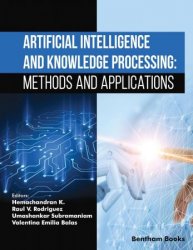 Название: Artificial Intelligence and Knowledge Processing: Methods and Applications
Название: Artificial Intelligence and Knowledge Processing: Methods and ApplicationsАвтор: Hemachandran K., Raul V. Rodriguez, Umashankar Subramaniam
Издательство: Bentham Science Publishers
Год: 2023
Страниц: 241
Язык: английский
Формат: pdf (true)
Размер: 38.8 MB
Artificial Intelligence and Knowledge Processing: Methods and Applications demonstrates the transformative power of Artificial Intelligence (AI) in our lives. The book is a collection of 14 edited reviews that cover a wide range of topics showcasing the application of AI and Machine Learning to create knowledge, and facilitate different processes.
The book starts by illuminating how AI is employed in robotics, IoT, marketing, and operations. It showcases how AI extracts insights from big data, optimizes museum management, and empowers automated garden path planning using reinforcement learning. The book also explores how AI can be used to predict heart disease using artificial neural networks. Furthermore, the book underscores how AI predicts crop suitability, manages crop systems, and can even help to detect violence in using computer vision. Chapters highlight specific techniques or systems such as recommendation systems and Reinforcement Learning where appropriate.
The Naive Bayes algorithm is a supervised learning algorithm that is used to solve classification problems and is based on Bayes' theorem. It is one of the simplest and most effective classification algorithms, assisting in the development of fast Machine Learning models which are capable of making quick predictions. It is most commonly used in text classification with high-dimensional training datasets. This is a probabilistic classifier, which means it makes predictions based on an object's probability.
Python will be used during coding in this book due to its popularity in AI and IoT platforms. To do AI/ML analytics on the data, specific supporting libraries like NumPy, Pandas, SciPy, Keras, and TensorFlow will be required. We'll be using Seaborn and Matplotlib for visualisation.
A high-level API named Keres is built on top of TensorFlow. It enables quick and simple prototyping. It supports convolutional neural networks, recurrent neural networks, and a hybrid of the two. It performs well on CPUs and GPUs alike.
The programme was developed by the Google Brain team and is an open-source framework called TensorFlow that has deep neural network implementation techniques and APIs. This can be used to work on a variety of platforms, including distributed, mobile, GPU, and CPU. Python, R, C++, Java, and Go are all compatible. TensorFlow makes it straightforward to use models in practical contexts and deploy them. The optimizer in TensorFlow streamlines the process of training deep neural networks by mechanically calculating gradients, which can subsequently be used to modify weights and bias.
Key Features:
· Showcases a wide range of AI applications
· Bridges theory and practice with real-word insights
· Uses accessible language to explain complex AI concepts
· Includes references for advanced readers
This book is intended as a guide for a broad range of readers who want to learn about AI applications and the profound influence it has on our lives.
Readership:
General readers, students, researchers and entrepreneurs interested in AI use-cases and applications.
Скачать Artificial Intelligence and Knowledge Processing: Methods and Applications